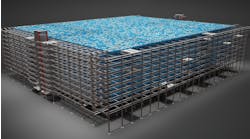With the upcoming arrival of 5G, internet speeds will become much faster and we will welcome in a new era of technology. This should roll out nationwide in 2019 and the early parts of 2020, but what does this mean for manufacturers and how can they ensure they are prepared for this new wave of technology?
This rise in 5G will lead to an even more seamless experience for receiving data. Faster speeds can offer more video usage and far more access to data. Allowing manufacturers, the chance to further improve upon their operations, today's younger generations are already consumed daily on YouTube and 5G will make this even easier and accessible to absorb anytime, anyplace.
Download Qualcomm's white paper "Making 5G NR a reality" for an in-depth look
For enterprises to be equipped to handle these new upgrades, they will need to adjust operations. Due to the possible increase in data consumption, many of the BYOD tools in place today (within enterprise workplaces) can be used to curb many challenges. Below are a few different trends for manufacturers to look out for when it comes to the adoption of 5G.
Faster and more reliable Video Speeds
With increased network speeds, the use of video will be easier to access. Manufacturers that utilize remote training, video conferencing and video for marketing and sales functions should see an uptick in productivity. This means better communications and fewer issues with video buffering and latency. Whether onboarding new employees or conducting meetings over a webinar, manufacturers will be able to work much faster thanks to more robust speeds that will be made with video.
We could also envision more real-time manufacturing monitoring. Together with growing centralized cloud-based software around Artificial Intelligence (AI) and computing horse power, video feeds could be monitored and alerted upon for defects, assembly, temperature (with the proper video equipment), or safety issues. Instead of using WIFI (see the new WiFi 6 standard), 5G can deliver the promise of mobility and can be a better choice with environments with non-stationary processes.
Better Connectivity Indoors
Manufacturers will also be impacted when it comes to indoor connectivity challenges, as 74% of U.S. workers in the warehouse and enterprise industries report they ‘frequently’ have issues with connectivity. Mobile coverage is especially essential, as employees now rely on it on a day to day basis. Carriers are already planning massive infrastructure upgrades in their towers, and due to 5G frequency bands, will also need more connectivity points than ever before. This could lead to even better connectivity indoors which is a top priority for manufacturers. Whether it is a worker taking inventory on a mobile device or tracking machine maintenance, having better connectivity indoors will lead to more efficient plants.
Security Risks
With the influx of 5G data speeds, a cyber-attack could perhaps happen faster, leading to more data that could potentially be leaked even quicker. This puts numerous plant devices in harm's way if not properly outfitted to mitigate these security risks. From rugged tablets on the floor to remote field devices and even BYOD, there are many moving parts for manufacturers to think about. With the adoption of 5G, it is a good time to review security precautions that should be taken to protect company data - whether that be a multi-authentication login on devices to apps that encrypt or wipe data in the case of missing or compromised devices.
Improved Remote Support
Lower latency aspects will make remote support a reality for a wide range of critical use cases, which were not possible before. From off-site control of equipment to data analysis, remote work will be a much more seamless process. Faster speeds will blur the lines between remote and on-site as quality support will not be limited by location.
With 5G, internet speeds will reach a new level. Connectivity will improve and will help to make plant operations more efficient. From remote support to inventory tracking, mobile tasks will be made easier due to the adoption of 5G. However, these faster speeds can bring on increased security risks. 5G presents a great opportunity for manufacturers, but only if they are able to properly secure their devices.
Marco Nielsen is the VP of Managed Mobility Services at Stratix.











